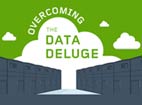The data center is becoming more efficient by the day. This much is a given. But data loads are also increasing at an exponential rate, which leads many to believe that the two trends will cancel each other out: more data, but processed more efficiently, leading to a net neutral effect on things like energy consumption.
But is this really the case? Will our insatiable demand for data be met in perpetuity, or is there a risk that at some point it will exceed the support capabilities of worldwide energy production?
For starters, let’s look at the data side. According to Synergy Research Group, the cloud market alone is growing at a rate of about 28 percent per year. This is in terms of revenue growth, not infrastructure development, but it still points to a rapidly expanding market that will have to invest in new buildings and systems if it hopes to maintain this pace. And since this is the cloud, expect these facilities to be large and getting larger. The silver lining, of course, is that giant regional facilities serving multiple enterprises are bound to be more efficient than multiple smaller data centers each serving one owner.
Meanwhile, the data center power market is growing at about 10.7 percent per year, according to MarketsandMarkets. The hottest growth is in the Asia-Pacific region, which is expected to be running at about 20 percent per year by the end of the decade, but the larger installed base in Europe and North America should still maintain its status as the top consumers of enterprise power equipment, and thus energy, for a while longer. Again, the news is not all bad here: New deployments are more efficient than the older systems they replace, so this activity does represent increased consumption of both data and energy, but it also means more efficient use of both.
So does this mean we should put on our Alfred E. Neuman masks and ask “What, me worry?” Not by a longshot, according to Northbridge Energy Partners. The group recent released a study that points to a growing gap between the needs of the data-driven economy and the capabilities of the world’s power grid. The report crunches a lot of numbers, but one of the most significant findings is that “growing data center efficiencies are unlikely to keep pace with the surging demand for data storage.” Global data center consumption is already at about 3 percent of energy output, which is double that of just five years ago, and with the Internet of Things coming online, we could see demand spike seven- to eight-fold by the end of the decade. No, this won’t completely overwhelm the grid, but at some point it will start to affect that ability to deliver power to other crucial needs, such as manufacturing and residential needs, leading to price fluctuations and other disruptions.
This leads to another question regarding our data usage: If we are going to devote exorbitant amounts of energy to data, then what value can we expect to receive? As The Atlantic’s Ingrid Burrington notes, the biggest data-related energy hogs are real-time, rich media content, such as video streaming. So is it really worth the cost and the environmental consequences to maintain this efficient yet still energy-draining infrastructure just so the world can go on an extended Netflix binge? Utilizing efficient, renewable energy for all of our data needs is a novel idea, and one that is taking hold among the top data companies across the globe, but until the energy sector is ready and willing to bring new power generation capabilities online, we are still left with the basic conundrum: rapidly growing consumption vs. limited supply.
Gloom and doom scenarios are common facets of modern life, but somehow mankind seems to muddle through. Still, it never hurts to be aware of where the trend lines are heading and to at least try to prevent some of the more extreme consequences of human activity.
The data industry must play its part by continuing to refine the ratio between data and power consumption, but at some point we should all take stock of the way we use our valuable data resources and decide if the benefit is really worth the cost.
Arthur Cole writes about infrastructure for IT Business Edge. Cole has been covering the high-tech media and computing industries for more than 20 years, having served as editor of TV Technology, Video Technology News, Internet News and Multimedia Weekly. His contributions have appeared in Communications Today and Enterprise Networking Planet and as web content for numerous high-tech clients like TwinStrata and Carpathia. Follow Art on Twitter @acole602.



